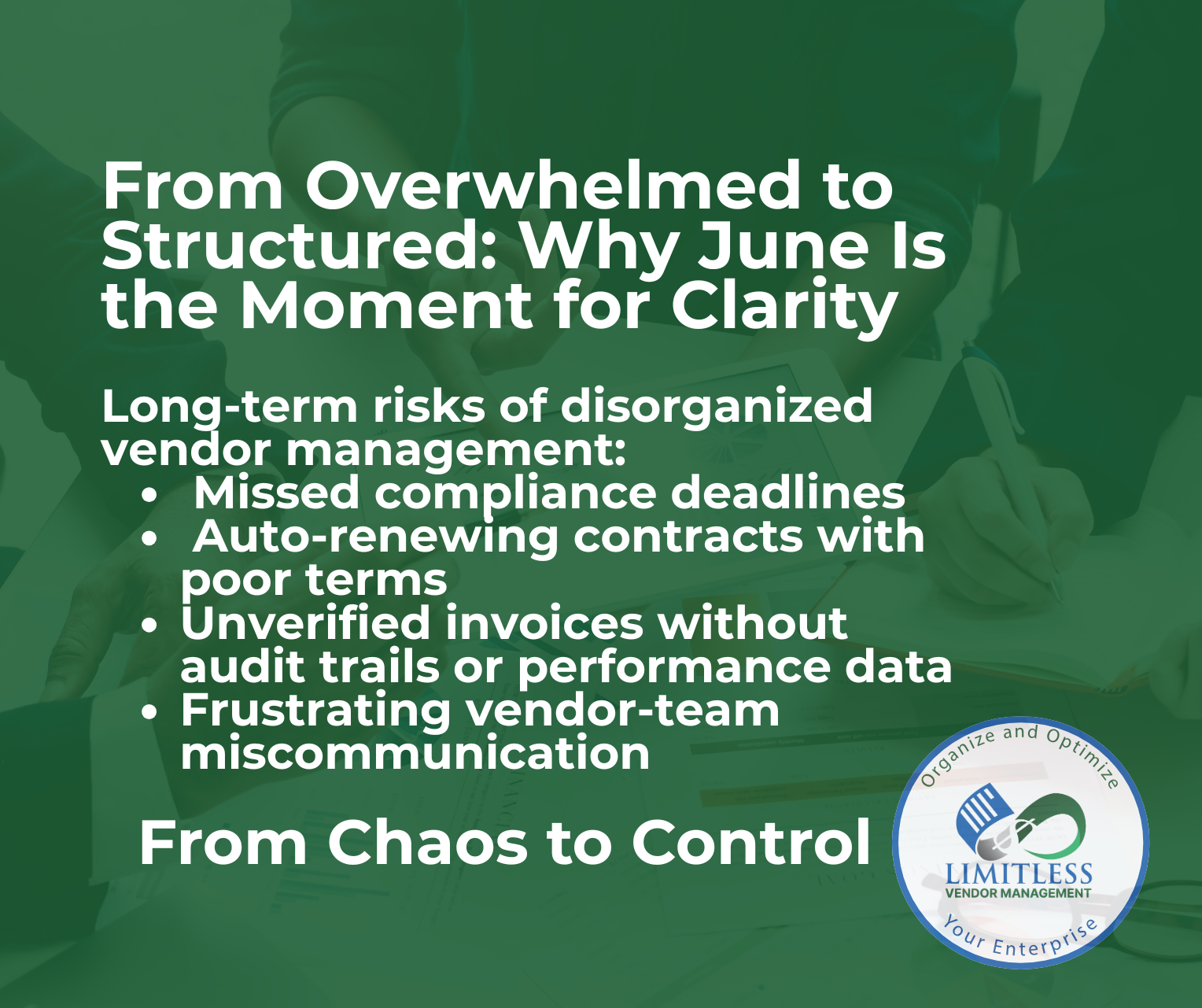From Overwhelmed to Organized: Why June Is the Perfect Time to Transform Your Vendor Strategy
As we move into June, many companies find themselves reflecting on the first half of the year. Operational goals may have shifted. Budgets are under review. Teams are feeling stretched—and vendor management is likely one of the most overlooked areas causing unnecessary friction.
Whether you’re managing a few dozen or several hundred third-party vendors, the complexities multiply fast: different contract terms, multiple points of contact, outdated billing systems, and performance metrics no one is tracking. Add it up, and you’ve got a recipe for lost time and wasted money!
If this sounds familiar, now is the time to pivot from reactive to proactive. It’s time to go from overwhelmed to organized—and June is the perfect month to do it.
Why June Is Your Moment for Vendor Transformation
Think about where you are in your business cycle. January to March was all about starting the year strong. April and May is usually spent catching up. June, however, offers a moment of clarity. You’re deep enough into the year to see patterns but early enough to pivot.
It’s the sweet spot for evaluating:
- Which vendors are supporting your growth—and which are slowing you down
- Which contracts are set to auto-renew
- Whether your internal teams are wasting valuable time trying to manage vendor chaos
Vendor disorganization doesn’t just cost you money. According to a recent McKinsey study, companies lose 10–20% of their potential efficiency due to unmanaged vendor relationships and fragmented systems.
Tip: If multiple departments are managing their own vendor relationships without a centralized system, you’re likely overpaying or duplicating services—sometimes both.
The True Cost of Staying Disorganized
Many business leaders underestimate the long-term risks of fragmented vendor management:
- Missed compliance deadlines
- Poor contract terms that renew automatically
- Disjointed communication that frustrates both vendors and staff
- Invoices being approved with no audit trail or performance metrics
Over time, these issues stall growth by creating confusion, errors, and unaccountable spending. At Limitless Vendor Management, we’ve seen firsthand how the absence of a structured vendor strategy leads to stalled operations, inaccurate forecasting, and team burnout.
What’s worse? The bigger you grow, the bigger the problem becomes—because the more vendors you work with, the more your inefficiencies scale.
Your Mid-Year Reset Plan
Here’s what a vendor strategy reset can look like this month:
- Inventory all active vendors and categorize by spend, service, and location.
- Centralize contracts using a VMS (Vendor Management System) to gain total visibility.
- Implement quarterly audits to catch errors, billing discrepancies, or compliance issues.
- Consolidate and renegotiate where possible using benchmark data and performance insights.
- Assign a Vendor Accountability Manager (VAM) or partner with a service provider who specializes in vendor strategy.
“Businesses don’t fail because they don’t grow fast enough—they fail when their systems can’t keep up. Vendor organization is the foundation of operational agility and scalability.”
Todd Larsen, CEO of Limitless Vendor Management
The Payoff: From Disarray to Growth Engine
Once you’ve cleaned up your vendor process, the results are immediate and ongoing:
- Consistent cost tracking
- Improved vendor performance
- Fewer billing surprises
- Faster decisions with reliable vendor data
- More time back for your internal team to focus on what they do best
You’ll also gain leverage—because nothing increases your negotiation power like organized data, usage reports, and performance metrics that back your position.
📊 Ready to turn chaos into clarity?
Partner with Limitless to organize and optimize your vendor strategy.

